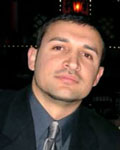
Artist Biography
Born on March 13, 1973 in Southern California, Antonio Pelayo is product of two cultures, both influentially and emotionally. Mexico, the land of myth and legend where he was raised for several years, and America, the country he was born in, left and later returned to with an outsider's view on the world.
At the young age of nine years old, Antonio was sent back to his father's village, El Palmar de Los Pelayo, in the rural countryside of Mexico to be raised in a strict Catholic atmosphere. The only problem was that Antonio and his mother and sisters were devout Jehovah's Witness. Needless to say, the young Antonio, who's Spanish was limited at the time, found himself ostracized from the community. With a different religious belief and speaking a different language from the other children in the community, Antonio found himself alone most of the time. He turned inward to find solace during these difficult times.
Antonio picked up a pencil, brought it to paper and a new universe was created for him to escape into. No longer would he be the odd man out. He created a world that was unto him and him alone. Drawing day and night Antonio created different worlds, people and animals. His skills were honed down daily as he drew incessantly. His early artistic influences, he confesses, came from a strange place. Antonio would sometimes sneak into the Catholic Church near him and marvel at the frescos of Jesus and Saints suffering in their martyrdom. Not wanting to be caught, he would sit quietly in the back of dark churches in the late afternoon and copy the artwork he saw on the walls. This would lead to his fascination with Mexican muralists Diego Rivera, Siquieros and Orozco. He saw the humanistic side to their art and it struck a deep cord in the impressionable Antonio. During this time Antonio was also starting to pick up the Spanish language and though he could speak Spanish he still was not able to "communicate" with the people of his village. He would always be considered an outsider, a role he was used to playing.
Several years later Antonio and his mother and sisters came back to America. He now felt like the proverbial "Man Without a Country." He didn't consider himself an American anymore and he never fully embraced his Mexican roots. Once again Antonio had to acclimate himself to another world, a world he vaguely remembered. The one constant thing in his life at this time was his artwork. But in America he had more opportunity to seek out different artistic influences. It was at a young age that he came upon the inspiration of many young artists. Some of the talent that Antonio would revere was the fantastic work of Frank Frazetta, the technical expertise of Boris Vallejo and the surreal bio-morphic talents of H.R. Giger. Other artists that were influential were Frida Kalo, Picasso and Dali. Totally self-taught as an artist, Antonio feels the strongest connection to his art when he does a portrait. "I've tried landscapes, still life, fantasy scenes but what really captures me is when I do a portrait, especially a portrait of someone I know or admire. There is an intimacy achieved between the subject and the artist, an honesty that goes both ways. You honestly try to convey what is there in your subject or what you honestly believe is there and the subjects leave themselves open and vulnerable to your interpretation. Trust goes both ways."
Antonio has always considered himself to be the ultimate outside observer. He never wanted to embrace a certain culture or a certain way of life, he'd rather walk around the edges of different worlds and take a peek in at times and draw what he saw. As far as living in any specific world, the only world he feels completely at home in is the one he creates himself with his art.
